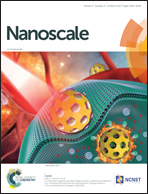The preparation of anisotropic hybrid nanostructures based on CdSe and CdS by the ligand combination method†
Abstract
CdSe and CdS nanoparticles (NPs) are type I II–VI semiconductor materials with excellent optical properties. Usually various shapes of these NPs show a strong emission only from a CdSe or CdS single domain, while the emission from a CdSe core combined with a CdS shell is effectively suppressed due to the ultrafast hole relaxation from the CdS shell into the CdSe core. Therefore, the design and synthesis of heteronanostructures based on CdSe or CdS is of paramount importance in designing the ways of integrating these useful semiconductor materials into complex hybrid structures. Here we demonstrate the ligand-combination inducing growth method to prepare anisotropic core–shell (semiconductor–semiconductor) heteronanostructures, as well as anisotropic Au–semiconductor heteronanostructures. The NPs’ anisotropic shape was confirmed by tilting a grid in TEM and their elemental composition was ascertained using EDX mapping in STEM mode. Furthermore, the photoluminescence excitation spectra were studied showing potential applications based on their unique optical properties. We believe that the mechanism investigation, the synthetic control, the obtained novel hybrid nanostructures and their optical properties will open doors to future studies on heterostructures based on semiconductors.



 Please wait while we load your content...
Please wait while we load your content...